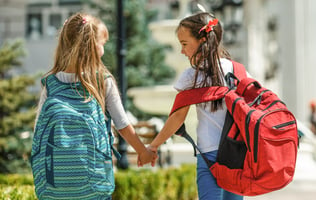The Sweet Symphony of Silence: Parents Relishing the Return to School As the first week of January...
The Joy and Responsibility of Raising a Puppy
 Mackenzie, 8 weeks
Mackenzie, 8 weeks
Bringing home a new puppy is one of life’s most heartwarming experiences—tiny paws pattering across the floor, eager tail wags and soulful eyes filled with curiosity all create joy. However, beneath the excitement lies a profound responsibility; raising a well-balanced, happy dog requires patience, consistency and abundant love.
A Rocky Beginning: Mackenzie’s First Night
Mackenzie’s first night was nothing like the picture-perfect puppy homecoming I had imagined. She arrived drenched, shivering and terrified. After being separated from her litter and flown down from Queensland, she was a bundle of anxiety. When I picked her up from the airport, she had tipped over her water, soaking her tiny body. Whimpering and curled up in the corner of her crate, she was overwhelmed by the unfamiliar sights and smells.
I scooped her up, wrapped her in a towel and held her close. Her body trembled against mine as I whispered reassurances. In that moment, I made her a silent promise: no matter what, she was home now and safe. That night, she barely left my side, her tiny body pressing against me as she drifted into an uneasy sleep. It was a reminder that raising a puppy isn’t just about playtime and cuddles—it’s about providing comfort and security in an uncertain world.
Early Socialisation: Helping Your Puppy Feel Safe
Think of your puppy as a tiny explorer in a vast new world. Every sound, smell and experience shapes who they will become. The first few months are crucial for socialisation—introducing them to different people, environments and situations in a controlled, positive way.
Take them to pet-friendly cafés, let them experience the hum of traffic, even introduce them to different floor textures. Allow them to watch the world, sniff inquisitively and observe new people without being overwhelmed. Encourage gentle interactions, but ask others not to rush to touch your puppy. This helps prevent overstimulation and ensures your pup learns confidence at their own pace.
Finding the Balance: Avoid Over-Stimulation
One evening, you might notice your puppy darting around in a frenzy—chasing their tail, nipping at anything in sight, refusing to settle. This isn’t just play; it’s a sign of over-stimulation. Puppies absorb so much during the day that they need plenty of sleep—sometimes up to 18 hours!
If your puppy becomes restless or overtired, guide them to a quiet, cosy spot. A crate or designated bed becomes a haven where they process their day in peace. Just like a child after an exciting birthday party, they need downtime to reset.
 Barb and Mackenzie
Barb and Mackenzie
The Comfort of Crate Training
Many new puppy owners feel uncertain about crate training, fearing it might be restrictive. But when introduced properly, a crate is a source of security rather than confinement.
Imagine a toddler building a fort out of blankets—it’s their safe space. A crate serves the same purpose for your puppy. Start by making it inviting: add soft bedding, a favourite toy and offer treats when they enter voluntarily. Never use it as punishment. With time, your puppy will see it as their retreat, easing separation anxiety and helping with house training.
Puppy School: A Classroom for Canine Success
Enrolling in puppy school isn’t just about obedience—it’s about setting a foundation for lifelong learning.
Picture a group of wobbly-legged pups learning to sit, stay and come when called. The controlled environment allows them to socialise safely while you gain valuable training tips. Under professional guidance, puppies learn essential skills like polite greetings and impulse control. And for you? It’s a chance to connect with other puppy parents who are navigating the same joys and challenges.
Ditch the Food Bowl: Make Mealtime an Adventure
Rather than simply placing food in a bowl, why not turn meals into enrichment activities? Scatter kibble in the grass, hide food in puzzle toys, or use a snuffle mat to encourage natural foraging instincts.
Handfeeding during training sessions builds trust and strengthens your bond. Watching your puppy excitedly sniff out their meal adds an extra layer of mental stimulation—plus, it slows down eager eaters to promote healthy digestion.
 Mackenzie
Mackenzie
The Magic of Playtime
Play is more than just fun—it’s an essential part of your puppy’s development.
Think of play as a learning tool: tug-of-war teaches bite inhibition, puzzle toys encourage problem-solving, and fetch strengthens recall skills. Rotate toys to keep things exciting and always balance play with quiet time. After an energetic session, guide your puppy to their bed or crate for a short wind-down period. This teaches them to self-soothe and prevents overstimulation.
Love, Grooming and Daily Care
Grooming isn’t just about keeping your puppy looking adorable—it’s a bonding ritual that reinforces trust.
Introduce brushing slowly, using treats and gentle praise to make it enjoyable. The same goes for bath time. Instead of a sudden, overwhelming dunk in water, ease them in. Let them stand in the tub while you gently run water nearby and offer a lick mat smeared with peanut butter as a distraction. Soon, they’ll associate grooming with positive experiences.
From Fearful to Fearless: Mackenzie’s Transformation
Now, four months later, Mackenzie greets every morning with joyful tail wags, confident and full of life. The once-nervous pup who clung to me for comfort and wailed when I was out of sight now bounds ahead on our walks, eager to explore the world. Seeing her transformation has been the most rewarding part of this journey.
Raising a puppy is about more than training and routines—it’s about trust, love and companionship. It’s about being their guide through the big, wide world and watching them grow into the dog they were meant to be.
What was your first night with your puppy like? Share your stories in the comments—I’d love to hear them!
 Renskie keeping her puppy calm and content in a busy environment
Renskie keeping her puppy calm and content in a busy environment



